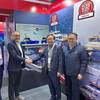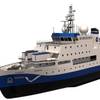The U.S. Navy commissioned the newest ship to enter the fleet, the Aegis guided missile destroyer, USS Pinckney (DDG 91). Pinckney honors Navy Cook First Class William Pinckney (1915-1976), recipient of the Navy Cross for his courageous rescue of a fellow crewmember onboard the USS Enterprise (CV 6) during the Battle of the Santa Cruz Islands in 1942. The commissioning took place in a ceremony at Naval Base Ventura County on Saturday. The ship is the 19th Arleigh Burke Class destroyer built by Northrop Grumman Corporation (NYSE: NOC), and the 10th ship to honor an African-American.
When an explosion killed four of the six men at his battle station in an ammunition handling room, Pinckney and the other surviving sailor attempted to exit through a hatch to the hangar deck above.When the other man grasped the scorching hatch, he fell back unconscious. Despite the suffocating smoke, flames and gasoline fumes surrounding him, Pinckney carried the sailor to safety. It was for this selfless heroism that Pinckney was awarded the Navy Cross. The Honorable John J. Young Jr., assistant secretary of the Navy for research, development and acquisition, delivered the principal commissioning address.
"The Navy acquisition team and our industry partners have delivered a ship which can dominate the area around her," Secretary Young said. "I believe the Northrop Grumman team, the Navy acquisition team, and the Pinckney crew have delivered great value for the taxpayer. This ship represents a commitment by America to open sea-lanes for global trade and to deliver overwhelming combat power if required."
The ship's sponsor, Mrs. Henrietta Middleton Pinckney, widow of William Pinckney, made a call to "man this ship and bring her to life." In response, the crew of nearly 400 officers and enlisted personnel took to the decks of Pinckney and "manned the rails" before more than 5,000 guests. James Bagwell, son of the USS Enterprise (CV 6) crewmember William Pinckney saved in 1942, then passed the ship's ceremonial long glass to DDG 91's first Officer of the Deck, Ensign Amy Jones, USN, operations information division officer.
Dr. Philip A. Dur, Northrop Grumman corporate vice president and president, Northrop Grumman Ship Systems, noted that, "Our national security turns on a powerful Navy and a strong industry that will provide that Navy. The 20,000 men and women of Northrop Grumman Ship Systems are proud to have been a part of putting Pinckney into service, giving the Navy the most technologically advanced warship available." Dur continued, "Northrop Grumman Ship Systems is dedicated to building quality warships, finding effective cost reductions, and favoring innovating research and development…a critical part of creating the 21st century Navy this country needs."
Aegis destroyers are equipped to conduct a variety of missions, from peacetime presence and crisis management to sea control and power projection, in support of national military strategy. These multi-mission ships provide primary protection for the Navy's aircraft carriers and battle groups, as well as essential escort to Navy and U.S. Marine Corps amphibious forces, combat logistics ships and convoys. Pinckney is also the first ship in the U.S. arsenal with a remote mine hunting system.
"Pinckney is clearly built to fight, and is the product of an extraordinary Navy/industry team that is second to none in its commitment to professionalism ... they have clearly built the best. I could not be prouder of their efforts," said Rear Adm. Charles Hamilton II, USN, program executive officer, ships. "I can think of no more fitting way to honor these courageous individuals than through the execution of this critical mission, the commissioning of our nation's newest warship USS Pinckney, the 41st ship in the long, proud line of the Arleigh Burke class, and the most technologically advanced warship ever put to sea."
Navy Cmdr. Robert M. Byron, of Asheville, N.C., commands USS Pinckney, now officially a part of the U.S. Pacific Fleet, Destroyer Squadron 1. "Thousands of defense contractors dedicated their efforts to produce the absolute best in American industrial capabilities," Byron said. "Thousands of people worked very hard to make this day happen; to give this brilliant technological achievement life.We thank you."
Subscribe for
Maritime Reporter E-News
Maritime Reporter E-News is the maritime industry's largest circulation and most authoritative ENews Service, delivered to your Email five times per week










